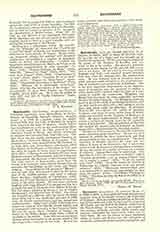

Hautefeuille, JEAN DE, French physicist, b. at Orleans, March 20, 1647; d. there, October 18, 1724. He was the son of a baker and was brought up in humble circumstances. While a mere boy he attracted the notice of the Duchess of Bouillon and was aided by her in his studies. She proved a generous patroness to him during her life and left him a pension at her death. He travelled in her suite through England and Italy, and received several benefices from her, after his entrance into the ecclesiastical state. He was endowed with an inventive turn of mind, and gave much attention to the practical problems of mechanics and particularly of horology. One of his most important achievements in the improvement of timepieces was the proposal to employ a spiral spring with a balance wheel in place of a pendulum to control the mechanism. Huyghens and Hooke had also made the same suggestion, and each claimed the right of priority. To Huyghens, however, must be given the credit of perfecting the device, and the first watch provided with a hair spring is said to have been made under his direction. In acoustics Hautefeuille investigated the action of speaking trumpets, and wrote an essay on the cause of echoes, which was crowned by the Academy of Bordeaux in 1718. He made improvements in lenses, and suggested a method of raising water by the explosive action of gun-powder. The phenomenon of the tides also excited his interest, and he invented an instrument called a thalassameter for their registration.
Though not without genius, Hautefeuille lacked the power of perfecting his inventions. He was too often inclined to publish his ideas prematurely and then abandon them to take up something new. The Paris Academy of Sciences attested the value and usefulness of many of his discoveries, but it never conferred on him the honor of electing him as a member. He was the author of a number of essays on a variety of subjects. Among them may be mentioned: “Explication de l’effet des trompettes parlantes” (1673); “Pendule perpetuelle, avec un moyen d’elever l’eau par la poudre a canon” (1678); “L’art de respirer sous l’eau” (1692); “Nouvelle moyen de trouver la declinaison de l’aiguille aimantee avec une grande precision” (1683); “Microscope micrometrique, gnomon horizontal, et instrument pour prendre les hauteurs des astres” (1703); “Problemes d’horlogerie” (1719); “Nouveau systeme du flux et du reflux de la mer” (1719).
HENRY M. BROCK

